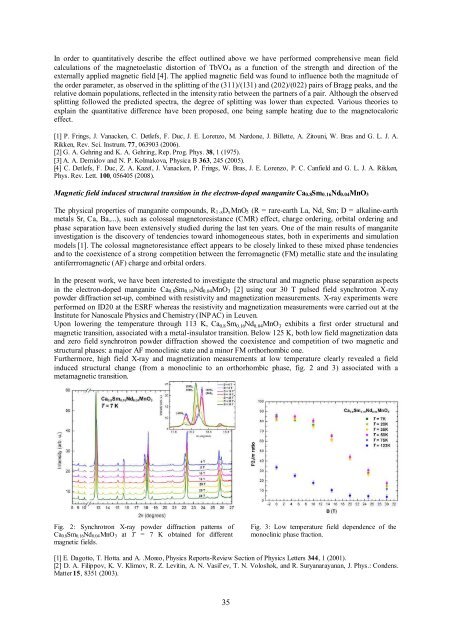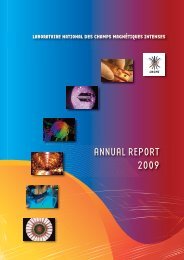Laboratoire National des Champs Magnétiques Pulsés CNRS – INSA
Laboratoire National des Champs Magnétiques Pulsés CNRS – INSA
Laboratoire National des Champs Magnétiques Pulsés CNRS – INSA
Create successful ePaper yourself
Turn your PDF publications into a flip-book with our unique Google optimized e-Paper software.
In order to quantitatively <strong>des</strong>cribe the effect outlined above we have performed comprehensive mean field<br />
calculations of the magnetoelastic distortion of TbVO4 as a function of the strength and direction of the<br />
externally applied magnetic field [4]. The applied magnetic field was found to influence both the magnitude of<br />
the order parameter, as observed in the splitting of the (311)/(131) and (202)/(022) pairs of Bragg peaks, and the<br />
relative domain populations, reflected in the intensity ratio between the partners of a pair. Although the observed<br />
splitting followed the predicted spectra, the degree of splitting was lower than expected. Various theories to<br />
explain the quantitative difference have been proposed, one being sample heating due to the magnetocaloric<br />
effect.<br />
[1] P. Frings, J. Vanacken, C. Detlefs, F. Duc, J. E. Lorenzo, M. Nardone, J. Billette, A. Zitouni, W. Bras and G. L. J. A.<br />
Rikken, Rev. Sci. Instrum. 77, 063903 (2006).<br />
[2] G. A. Gehring and K. A. Gehring, Rep. Prog. Phys. 38, 1 (1975).<br />
[3] A. A. Demidov and N. P. Kolmakova, Physica B 363, 245 (2005).<br />
[4] C. Detlefs, F. Duc, Z. A. Kazeĭ, J. Vanacken, P. Frings, W. Bras, J. E. Lorenzo, P. C. Canfield and G. L. J. A. Rikken,<br />
Phys. Rev. Lett. 100, 056405 (2008).<br />
Magnetic field induced structural transition in the electron-doped manganite Ca0.8Sm0.16Nd0.04MnO3<br />
The physical properties of manganite compounds, R1-xDxMnO3 (R = rare-earth La, Nd, Sm; D = alkaline-earth<br />
metals Sr, Ca, Ba,...), such as colossal magnetoresistance (CMR) effect, charge ordering, orbital ordering and<br />
phase separation have been extensively studied during the last ten years. One of the main results of manganite<br />
investigation is the discovery of tendencies toward inhomogeneous states, both in experiments and simulation<br />
models [1]. The colossal magnetoresistance effect appears to be closely linked to these mixed phase tendencies<br />
and to the coexistence of a strong competition between the ferromagnetic (FM) metallic state and the insulating<br />
antiferrromagnetic (AF) charge and orbital orders.<br />
In the present work, we have been interested to investigate the structural and magnetic phase separation aspects<br />
in the electron-doped manganite Ca0.8Sm0.16Nd0.04MnO3 [2] using our 30 T pulsed field synchrotron X-ray<br />
powder diffraction set-up, combined with resistivity and magnetization measurements. X-ray experiments were<br />
performed on ID20 at the ESRF whereas the resistivity and magnetization measurements were carried out at the<br />
Institute for Nanoscale Physics and Chemistry (INPAC) in Leuven.<br />
Upon lowering the temperature through 113 K, Ca 0.8Sm 0.16Nd 0.04MnO 3 exhibits a first order structural and<br />
magnetic transition, associated with a metal-insulator transition. Below 125 K, both low field magnetization data<br />
and zero field synchrotron powder diffraction showed the coexistence and competition of two magnetic and<br />
structural phases: a major AF monoclinic state and a minor FM orthorhombic one.<br />
Furthermore, high field X-ray and magnetization measurements at low temperature clearly revealed a field<br />
induced structural change (from a monoclinic to an orthorhombic phase, fig. 2 and 3) associated with a<br />
metamagnetic transition.<br />
Fig. 2: Synchrotron X-ray powder diffraction patterns of<br />
Ca0.8Sm0.16Nd0.04MnO3 at T = 7 K obtained for different<br />
magnetic fields.<br />
35<br />
Fig. 3: Low temperature field dependence of the<br />
monoclinic phase fraction.<br />
[1] E. Dagotto, T. Hotta. and A. .Moreo, Physics Reports-Review Section of Physics Letters 344, 1 (2001).<br />
[2] D. A. Filippov, K. V. Klimov, R. Z. Levitin, A. N. Vasil’ev, T. N. Voloshok, and R. Suryanarayanan, J. Phys.: Condens.<br />
Matter 15, 8351 (2003).







